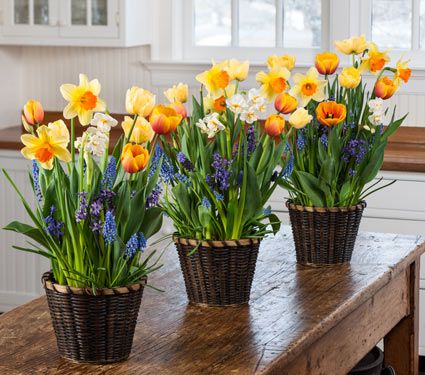






Forced Bulbs: Fragrant Blooms in Winter
Our Forced Bulb Collections are created for exceptional grace and beauty by combining bulbs in ways you are unlikely to find elsewhere. Every year, we test new arrangements in trials at the farm, selecting only the loveliest combinations. Winning collections are those in which the bulbs work together harmoniously - with the right proportions, concurrent bloom times, and complementary color schemes. The mixes are created by our head gardener, who studies bulb bloom-time charts and gathers advice from our Dutch bulb experts to make her selections. As a result, our combinations are full of variety and guaranteed to please.
How We Create Our Forced Bulb Collections
Many spring-flowering bulbs can be tricked or "forced" into bloom indoors - a satisfying and rewarding practice. But forcing bulbs in winter is for work for serious gardeners. With our forced bulb collections, we've already done the work. You get the blooms!
The principle of forcing is to prepare the potted bulbs for indoor bloom by first providing them with a simulated spring. This is done by placing the planted pots in a dark, cool location for about six weeks while they develop roots. Remember that the embryo leaves and flower buds, along with a store of nutrients, already exist within the bulb. All they require is some material to root into for moisture and support.
All of our forced bulb gifts are potted, pre-chilled and fully prepared to grow on arrival, needing only warm temperatures, light, and some water. Full instructions for care are included with every order.
Forced Bulb Collections Growing Tips
How to Care for Your Forced Bulb Collection
Our spring bulb collections (which may include Crocus, Hyacinths, Iris, Muscari, Narcissus, and Tulips) arrive potted, with a layer of protective Spanish Moss on top. Cut and remove the rubber band that holds the Spanish Moss in place. You may discard the Moss, or use it as a decorative element (as the bulbs grow, rearrange the Moss so that it does not become tangled in the foliage). Bulbs usually begin blooming in 4-5 weeks.
As your bulb garden grows, some plants may get leggy and fall over as they sometimes do in the garden. (This is especially true in lower light levels.) If that happens, treat your bulb garden as a cutting garden. Cut the flowers and enjoy them in vases.
Light: Place the pot where it will receive 6-8 hours of direct sun every day.
Watering: Water when the potting mix is dry to the touch. We recommend removing the pot from its basket before watering. Push any Spanish Moss aside, water the pot thoroughly and let it drain before replacing in the basket.
Temperature: A cool room with daytime temperatures below 70°F and nighttime temperatures about 50-55°F, such as is found near a window, is ideal. Please note that the growth of the bulbs will be slower in a cooler part of the house. Warmer temperatures may speed growth, but can result in weaker flowering stems.
Fertilizer: There is no need to fertilize.
Continuing Care: What you do with your bulbs after they bloom depends on your climate and your inclinations. The bulbs can't be forced to bloom indoors again, but they can be planted outdoors - if they are hardy in your area. (Most of the bulbs in our collections are winter hardy to at least Zone 4 [-30°F]. Continue to water the bulbs after they bloom and keep them in a sunny window. When the threat of hard frost has passed, plant each bulb with a trowel at a depth equivalent to about three times the bulb's height. Expect 2 or more years to pass before the bulbs bloom again. In our experience, caring for the bulbs after bloom and planting them out in spring is rarely worth the effort. We prefer simply to toss the bulbs out after they've finished blooming.
White Flower Farm is your dependable source for Forced Bulbs, Indoor Forcing Bulbs, and Flowering Forced Bulbs.
Copyright © www.100flowers.win Botanic Garden All Rights Reserved